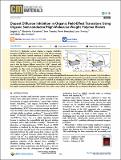Por favor, use este identificador para citar o enlazar a este item:
http://hdl.handle.net/10261/331038COMPARTIR / EXPORTAR:
 SHARE SHARE
 CORE
BASE CORE
BASE
|
|
| Visualizar otros formatos: MARC | Dublin Core | RDF | ORE | MODS | METS | DIDL | DATACITE | |

| Título: | Dopant Diffusion Inhibition in Organic Field-Effect Transistors Using Organic Semiconductor/High-Molecular-Weight Polymer Blends |
Autor: | Li, Jinghai; Colantoni, Elisabetta; Temiño, Inés; Branchini, Paolo; Tortora, Luca; Mas Torrent, Marta CSIC ORCID | Palabras clave: | Glass-transition Polystyrene |
Fecha de publicación: | 28-feb-2023 | Editor: | American Chemical Society | Citación: | Chemistry of Materials 35(4): 1527–1536 (2023) | Resumen: | Molecular contact doping in organic field-effect transistors (OFETs) has been proved to be a very efficient strategy to reduce the device contact resistance. It consists of inserting a dopant layer between the organic semiconductor (OSC) and the top gold contacts to reduce the energy barrier required to inject/release charges. However, a main bottle-neck for its implementation is that the dopant diffuses toward the OFET channel with time, doping the OSC, and hampering the on/off switching device capability. In this work, we fabricated OFETs based on the benchmark OSC 2,7-dioctyl[1]benzothieno[3,2-b][1]benzothiophene (C8-BTBT-C8) by a solution shearing technique. First, we show that the OFET performance of these devices is significantly improved when a layer of the p-dopant 2,3,5,6-tetrafluoro-7,7,8,8-tetracyanoquinodimethane (F4TCNQ) is inserted before the evaporation of the gold source/drain contacts. Remarkably, we demonstrate that the dopant diffusion can be controlled by blending the OSC with polystyrene (PS) of different molecular weights. In-depth electrical characterization combined with studies of surface and in-depth distribution of the dopant by time-of-flight secondary ion mass spectrometry (ToF-SIMS) unambiguously show that in thin films of OSC blends with high-molecular-weight PS, the dopant remained drastically confined into the contact areas, which was reflected by an enhanced long-term device stability. | Versión del editor: | http://doi.org/10.1021/acs.chemmater.2c02780 | URI: | http://hdl.handle.net/10261/331038 | DOI: | 10.1021/acs.chemmater.2c02780 | ISSN: | 0897-4756 |
| Aparece en las colecciones: | (ICMAB) Artículos |
Ficheros en este ítem:
| Fichero | Descripción | Tamaño | Formato | |
|---|---|---|---|---|
| Li_ChemMater_2023_editorial.pdf | Artículo principal | 7,83 MB | Adobe PDF |  Visualizar/Abrir |
| Li_ChemMater_2023_suppl_editorial.pdf | Información complementaria | 1,49 MB | Adobe PDF |  Visualizar/Abrir |
CORE Recommender
SCOPUSTM
Citations
5
checked on 12-may-2024
WEB OF SCIENCETM
Citations
2
checked on 23-feb-2024
Page view(s)
30
checked on 13-may-2024
Download(s)
46
checked on 13-may-2024
Google ScholarTM
Check
Altmetric
Altmetric
Este item está licenciado bajo una Licencia Creative Commons

